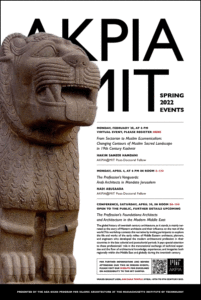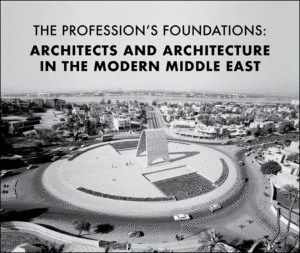Lectures, Conferences & Events» Past Lectures & Events


The Profession’s Vanguards: Arab Architects in Mandate Jerusalem
Nadi Abusaada
AKPIA@MIT Post-Doctoral Fellow
Abstract
Writings on architecture in Palestine and the Arab region in the first half of the twentieth century have often focused on the legacies of colonial architects and planners in shaping Arab cities and built environments. In this talk, Nadi Abusaada will highlight findings from his postdoctoral research on the overlooked history of the first milieu of trained Arab architects in Palestine, particularly in the city of Jerusalem. He will trace their professional trajectories and their development from the late Ottoman era and their continuities into the British Mandate period. Although these architects were working within the British colonial system, they nonetheless were able to forge their own understandings of the architectural profession and modern architecture. Importantly, they were not working in isolation. They considered themselves part of a broader quest for developing the architectural profession regionally within the Arab world. This talk will shed light on the transnational connections that linked the first milieu of Palestinian architects with their counterparts in the Arab region in the 1930s-40s.
Bio
Nadi Abusaada is an architect and a historian. He is currently an Aga Khan Postdoctoral Fellow at the Massachusetts Institute of Technology (MIT). Nadi completed his Ph.D. and M.Phil. degrees at the University of Cambridge and his B.A. at the University of Toronto. Nadi is also the co-founder of Arab Urbanism, a global network dedicated to historical and contemporary urban issues in the Arab region. His writings have been featured in a number of international publications including The Architectural Review, The International Journal of Islamic Architecture, and the Jerusalem Quarterly among others.
From Sectarian to Muslim Ecumenicalism: Changing Contours of Muslim Sacred Landscape in 19th Century Kashmir
Hakim Sameer Hamdani
AKPIA@MIT Post-Doctoral Fellow
Abstract
The beginning of nineteenth century marks the end of Muslim rule in Kashmir, when in 1820 this Himalayan region was annexed by the Sikh kingdom, bringing to close five centuries of Muslim rule in Kashmir. This political transformation is envisioned in native Muslim historiography as ‘a loss’, which affected not only the political fortunes of the community but also sources of patronage for construction and maintenance of religious sites. The paper seeks to examine how two historic Muslim religious sites in the region connected to Kashmiri Sunni and Shi’a society: the Khānaqāh-i Mʿaulā and the Mʿārak imāmbāda, came to define the transformation of a sectarian identity into the idea of a united Kashmiri Muslim self, navigating through the contours of sectarian differences and conflicts.
Bio
Hakim Sameer Hamdani is Design Director at INTACH Kashmir, whose primary area of research is in the field of Islamic religious Architecture of South Asia. He has widely written on the Muslim material culture of Kashmir. His major conservation projects are the Reconstruction of 18th century wooden Shrine of Pīr Dastgīr Ṣahib (2020–12) and Conservation of 15th century, ʿAāli Masjid at Eidgah, Srinagar (2007)— both of which were longlisted for the Aga Khan Award for Architecture, as well as the Mughal Gardens of Kashmir. He recently prepared the dossier for successful inclusion of Srinagar on the UNESCO’s Creative Cities Network (UCCN-2021).His book based on his doctoral research, The Syncretic Traditions of Islamic Religious Architecture of Kashmir (Early 14th ‐ 18th Century)was published by Routledge in March 2021. He is forthcoming book Shi’ism in Kashmir: A history of Sunni‐Shia rivalry and reconciliation, is being published by I B Tauris. He is also co-editing a book on Mughal Gardens of Kashmir.
He is presently pursuing his Post‐Doctoral fellowship in Islamic Architecture (2021‐22) at MIT.